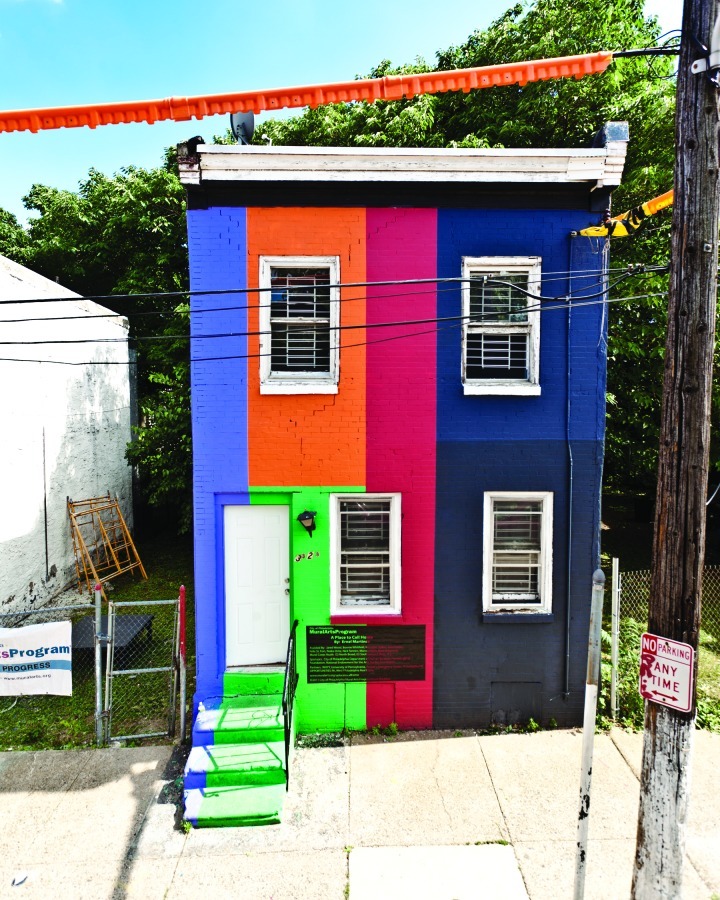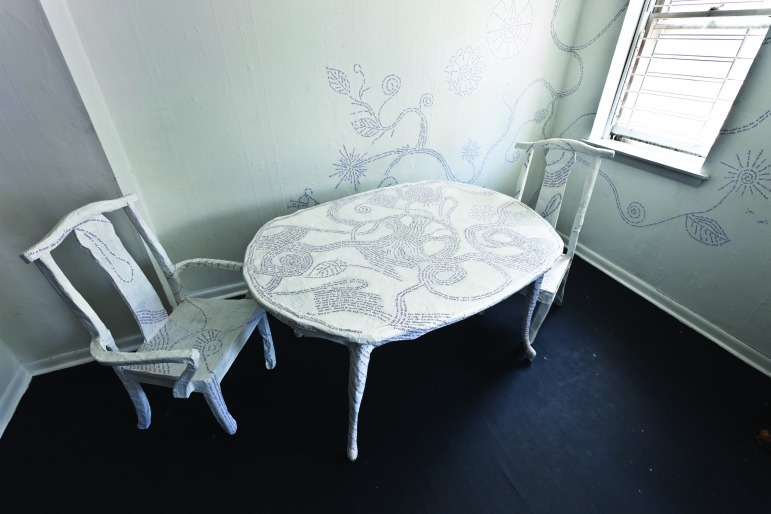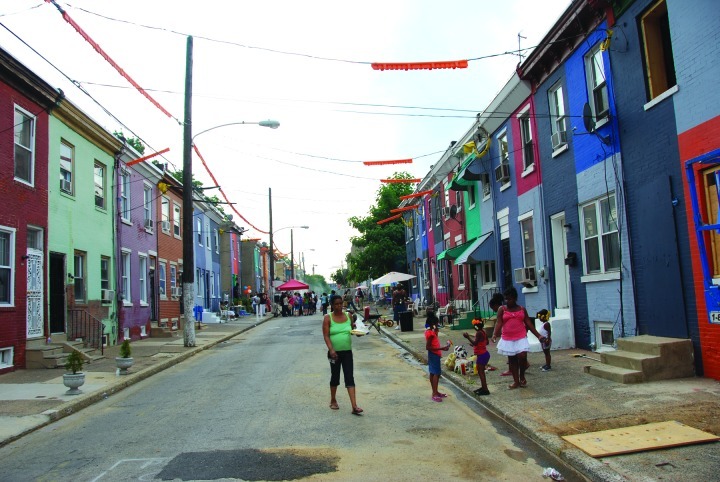PHILADELPHIA, PENNSYLVANIA, is a city of contradictions. Just beyond its vibrant and thriving downtown, Philadelphia's disadvantaged neighborhoods seem forlorn and forgotten, with too few people and too many broken windows. Philadelphia has 40 000 vacant and abandoned properties but more than 5000 homeless children.1,2
Acting on the conviction that “art ignites change,” the Mural Arts Program of Philadelphia launched the arts and advocacy initiative A Place to Call Home. The project's mission was to engage and empower high-risk young people, giving voice to their concerns about housing and health. The project engaged the community along with the youth participants, whose personal stories of housing insecurity and homelessness inspired provocative art aimed at making their invisible suffering a public concern.
At the start of the project, our team of researchers and artists was warned not to expect the same youth participants to show up week after week. The life challenges they face are too great, we were told, to allow for sustained participation.
The participants defied those expectations: 48 young people, ages 14 to 23, worked consistently for six months, engaging in neighborhood photo documentation,3 photo-elicitation interviews4 regarding their own housing struggles, and the creation of public art. The youth participants also received housing and employment counseling. To the surprise of team leaders, the young people promptly became effective advocates by recruiting additional friends in need of help. The only resistance came from a small group of residents near the project site, who initially questioned the motives of the team.
The youth participants—several of whom were accustomed to the negative attention of the criminal justice system—proudly attended the project exhibition. They brought adult family members, friends, and their own children to see the work they had helped to create. The audience included city council members, reporters, local residents, nonprofit leaders, and Mayor Michael Nutter, who announced his commitment to ending homelessness in Philadelphia.
The exhibit centered on a strikingly painted Art House, reclaimed from its former role as a crack house (Image 1). Just inside was a paper sculpture by Ernel Martinez, who used the transcripts from young people's photo-elicitation interviews to craft a dining table, chairs, and dinnerware (Image 2). Wallpaper incorporated words from the transcripts into whimsical, swirling flowers and vines, a deliberate contrast to what he called the heavy stories about being kicked out of homes, “couch surfing,” or living in shelters. In the next room and upstairs, visitors watched stop-motion animations by Damon Reaves (http://www.damonreaves.com/row.html) and heard an audio mural by Elizabeth Perez Luna from the local National Public Radio affiliate, WHYY (http://www.newsworks.org/index.php/a-place-to-call-home).
IMAGE 1—
An abandoned row home was donated by a local developer and transformed into an Art House for A Place to Call Home. The house also served as a base for distributing information about housing, legal aid, health care, and employment. Photograph by S. Weinik.
IMAGE 2—
Visitors to the Art House wanted to sit at this table, sculpted from young people's interview transcripts by Ernel Martinez. But the set itself was intentionally fragile—reflecting the instability and insecurity Martinez heard in so many of the young people's descriptions of their homes. Photograph by S. Weinik.
To spark conversations in the neighborhood, artist Shira Walinsky emblazoned nearby blocks with arresting images on the sides of row homes (Image 3). She also installed “guerilla murals” and wheat-pasted prints on abandoned buildings, often to cover graffiti or boarded windows and always to focus attention on the universal importance of home (Image 4).
IMAGE 3—
With vibrant colors and icons of domestic security, Shira Walinsky's murals called attention to the universal importance of home Photograph by C. C. Cannuscio.
IMAGE 4—
In a break from the usual work of the Mural Arts Program, which involves extensive community negotiations regarding how and where murals will be erected, Shira Walinsky installed a series of “guerilla murals” and wheat-pasted prints that marked a path to the Art House. Photograph by S. Weinik.
The project's most ambitious change transformed the distressed block surrounding the Art House (Image 5). Lots were cleaned, and houses were painted. Bold colors drew the homes together into a graphic mural designed by Ernel Martinez. This part of the project required community trust and cooperation, which had long been undermined by an active local drug trade. After weeks of outreach, most of the street's residents consented to have their homes painted. Now, the artwork stands as a sign of community solidarity.
IMAGE 5—
A block-long mural served to unite the struggling neighborhood, both visually and through residents’ participation in a community paint day. Photograph by C. C. Cannuscio.
Toward the end of the project, one of the originally resistant residents emerged from his house, broom in hand. He wanted to be a part of cleaning up the block.
He was living proof: art ignites change.
Acknowledgments
This City of Philadelphia Mural Arts Program project was supported by the Robert Wood Johnson Foundation Health & Society Scholars Program and the Mixed Methods Research Laboratory at the University of Pennsylvania, as well as the Philadelphia Department of Human Services, the Hummingbird Foundation, the National Endowment for the Arts, the Surdna Foundation, WHYY, People's Emergency Center, Philadelphia VIP, OPPORTUNITIES-PA, Weigle Information Commons, the Penn Project for Civic Engagement, and West Philadelphia Real Estate.
We thank the artists, staff, and participants of the Mural Arts Program and Katie Kellom, Shimrit Keddem, Dawn Mautner, and Breah Paciotti.
References
- 1.Catherine Lucey. “40,000 City Properties. Abandoned. Now What?” Philadelphia Inquirer. July 28, 2010.
- 2.Kathy Fisher and Shelly Yanoff. “Philadelphia Children and Youth Experiencing Homelessness,” http://www.pccy.org/userfiles/file/ChildWelfare/HomelessChildrenReport2010.pdf (accessed September 28, 2011).
- 3.Carolyn Cannuscio, Eve Weiss, Hannah Fruchtman, Jeannette Schroeder, Janet Weiner, and David Asch. “Visual Epidemiology: Photographs as Tools for Probing Street-Level Etiologies.” Social Science & Medicine 69 (2009): 553–64. [DOI] [PubMed]
- 4.Caroline Wang and Mary Ann Burris. “Photovoice: Concept, Methodology, and Use for Participatory Needs Assessment.” Health Education & Behavior 24 (1997): 369–87. [DOI] [PubMed]







